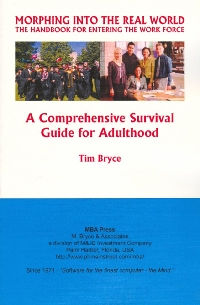 This is part two of a three part series which describes the fundamentals of management and should be of particular interest to young people entering the work force or as a refesher for managers. It is an excerpt from my book, "MORPHING INTO THE REAL WORLD - A Handbook for Entering the Work Force" which is a survival guide for young people as they transition into adult life. The book is available from MBA Press through our web site.
This is part two of a three part series which describes the fundamentals of management and should be of particular interest to young people entering the work force or as a refesher for managers. It is an excerpt from my book, "MORPHING INTO THE REAL WORLD - A Handbook for Entering the Work Force" which is a survival guide for young people as they transition into adult life. The book is available from MBA Press through our web site.
TYPES OF ORGANIZATIONAL STRUCTURES
Within any organization, be it commercial or nonprofit, there is always a chain of command that dictates how the organization will be governed. To this end, there are basically three types of organizational structures:
Hierarchical - representing a classic tree structure (top-down) defining administrative relationships between people. The hierarchical organization, as depicted by an organization chart, expresses superior, subordinate, and lateral relationships within an organization. It also suggests the scope of activities within an organization.
Matrix - represents a pool of people serving different capacities in an organization. For example, on one business function a person may represent the leader, on others he may be a follower. Under the matrix approach, one person may serve more than one leader.
Project Team - is similar to the Matrix except as performed on a project-to-project basis. In other words, a person's tasks are prescribed by the project for which he is assigned. He will serve in this capacity until the conclusion of the assignment, after which he will be assigned to another project in perhaps another capacity.
Regardless of how companies organize themselves, either in a multi-tiered hierarchy or in a flat organization, there is always a superior/subordinate relationship between personnel for administrative purposes. The notion that an organization runs as a pure democracy is a myth. There will always be a need for leaders and followers.
THE FIVE BASIC ELEMENTS OF MASS PRODUCTION
There is basically two ways of producing any product, either one at a time or in mass production. Mass production affords us the ability to produce more products at reduced costs. As such, industrial engineers have long known that in situations involving voluminous work products of the same type, an organization needs to observe the five basic elements of mass production:
1. Division of Labor - to break the production process into separate tasks performed by workers with different skills.
2. Assembly Line - defining the progression and synchronization of work.
3. Precision Tooling - for mechanical leverage in the assembly line.
4. Standardization of Parts - for inter changeability and assembly by unskilled and semiskilled workers.
5. Mass Demand - the impetus for mass production.
You will find these five elements in every company who offers repetitious work products, be it an automotive manufacturer, a restaurant, a bank or insurance company, an engineering firm, etc. Actually, more organizations operate in accordance with these five elements than those who do not.
These five elements lead to the need of standard and reusable methodologies representing the business processes needed to perform the work. Such methodologies define Who is to perform What work, When, Where, Why, and How (I refer to this as "5W+H").
UNDERSTANDING PRODUCTIVITY
Productivity = Effectiveness X Efficiency
Too often people fallaciously equate productivity with efficiency. Efficiency simply represents how fast we can perform a given task. For example, an industrial robot on an assembly line can perform a task such as welding very precisely and quickly. But if the weld is being performed at the wrong time or wrong place, then it is counterproductive, regardless of how efficiently it performs the task. Effectiveness, on the other hands, is concerned with the necessity of the task itself or as I like to say, "Do the right things." Under this scenario, the manager should consider effectiveness first, and efficiency second. By being conscious of both effectiveness and efficiency, the manager can avoid the "Rearranging the Deck Chairs on the Titanic" phenomenon whereby people work on the wrong things at the wrong time.
Undoubtedly, you will meet salesmen who will offer products promising improvements in efficiency. But if they cannot be implemented into your operation effectively, it will be counterproductive.
Just remember, 100% efficiency multiplied by 0% effectiveness equals zero productivity.
In terms of delivering a quality work product, the manager should understand the relationship of quality to the time necessary to produce the goods.
The faster the product is produced, the more likely it will contain defects in workmanship; conversely, the more time allowed in production, the greater the chances for producing a high-quality product. Although everyone stresses the need for quality, the reality is the manager must be able to balance development time against defects in workmanship and that a suitable development time needs to be devised to match the level of quality desired. This also means the level of precision in production is proportional to the level of quality desired, all of which will greatly influence a manager's style of management. For example, in a high pressure situation, the manager may exercise more supervision and a little friendly bullying in order to get the job done. Under less pressure, the manager will allow more worker freedom and participation in developing decisions.
NEXT TIME: We will conclude this three part series with a review of some important Laws and Rules to observe in the workplace.
In the meantime, if you would like to discuss this with me, please drop me a line at timb001@phmainstreet.com
Keep the Faith!
Note: All trademarks both marked and unmarked belong to their respective companies.
 Tim Bryce is a writer and the Managing Director of M. Bryce & Associates (MBA) of Palm Harbor, Florida and has over 30 years of experience in the management consulting field. He can be reached at timb001@phmainstreet.com
Tim Bryce is a writer and the Managing Director of M. Bryce & Associates (MBA) of Palm Harbor, Florida and has over 30 years of experience in the management consulting field. He can be reached at timb001@phmainstreet.com
For Tim's columns, see:
http://www.phmainstreet.com/timbryce.htm
Like the article? TELL A FRIEND.
Tune into Tim's THE BRYCE IS RIGHT! podcast Mondays-Fridays, 11:30am (Eastern).
Copyright © 2011 by Tim Bryce. All rights reserved.
No comments:
Post a Comment